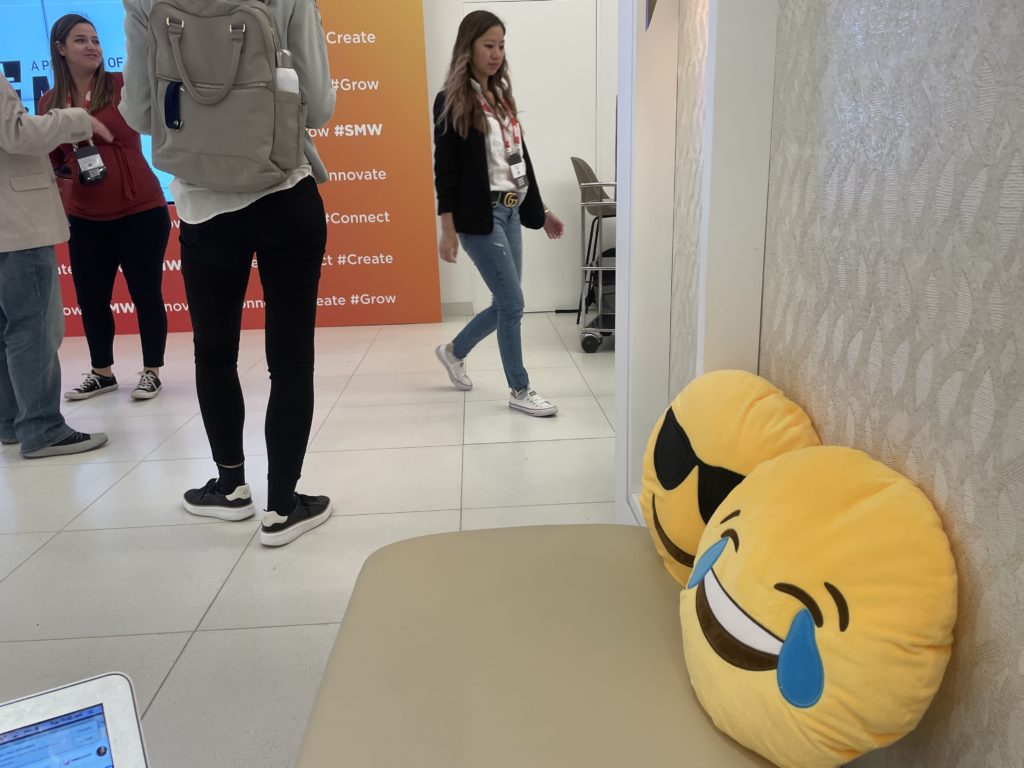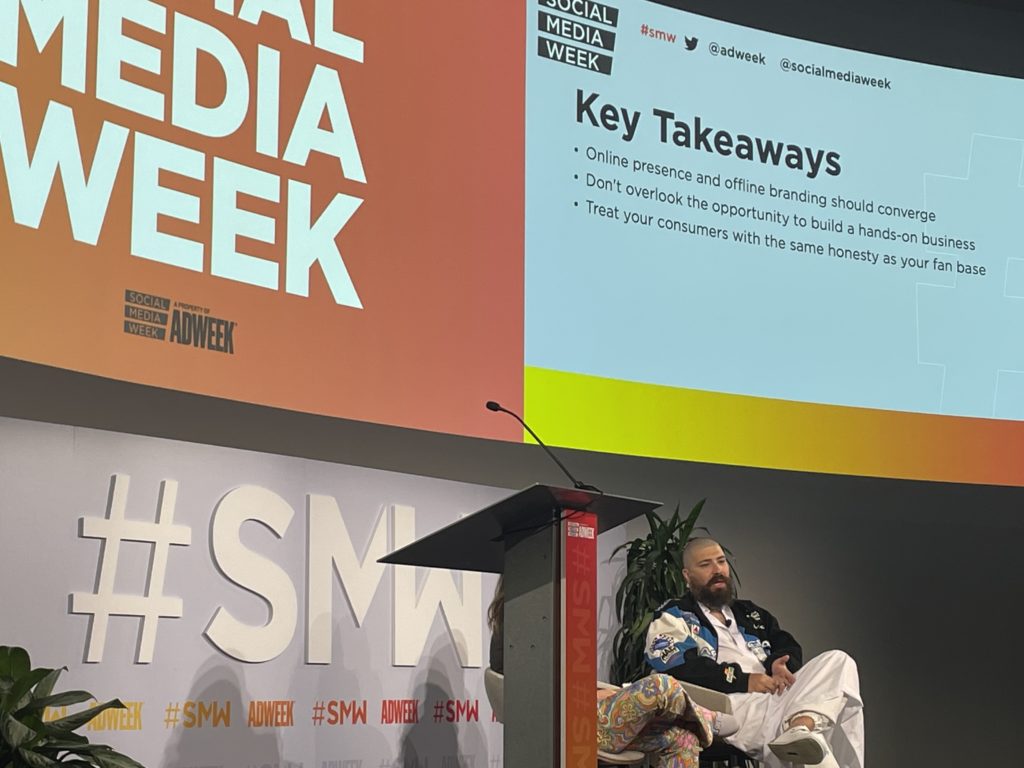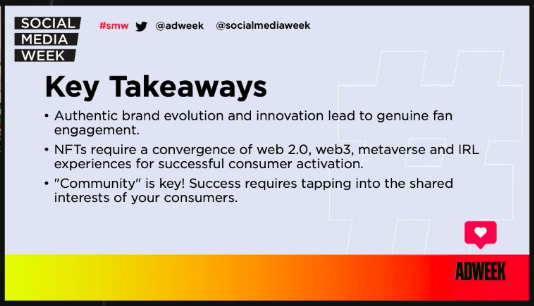Last week, I had the good fortune to attend Social Media Week (now owned by AdWeek), held in person for the first time since 2019. Every presenter shared their “key takeaways” so here are mine for the conference:
- Humanity was on full display
Over the last two years, our clients have told us that very few people turn up in person when an industry conference offers a virtual option. I expected to show up to SMW and see the same, but that is not how it played out. The main stage and breakout rooms were standing-room-only. I was even directed to an overflow room for one of the breakout sessions! This surprised me given SMW attendees tend to be digital natives and/or early adopters of all things virtual. People were clearly ready to see other people and the energy was pretty incredible.
The huge registration line on the first day was another indication of just how many attendees opted for in-person. The venue was the lower Manhattan location of Convene, a beautiful meeting space (the sparkling water on tap was a nice touch). I noticed the supervisor who was managing the entry area coached his team members not to call us “guys” when providing instructions — “No gendered language, please,” he said. Another dose of humanity.
There were emojis everywhere — all the feels — from posters to pillows. One presenter from the travel space was talking about all the sad emojis that kept popping up in their social listening tool. When he dug into the data he realized people were crying tears of joy.

Finally, several of the presenters, including on the main stage, shared with us that they were nervous. We’ve all been presenting through monitors for more than two years. I loved that people were willing to be real about the way they were feeling and the crowd was super supportive. At one point, a presenter couldn’t control the slides of their presentation and said, “Oh, Jesus take the wheel.” Another presenter’s microphone battery pack came unclipped from the waist of his pants and dropped to the floor. When it was time to stand up and present, he shrugged and said, “I guess I’ll just do this sitting down now.”
It was refreshing to see people embrace imperfection and it made the perfectly scripted presenters look like salespeople.
2. The creator economy is king
Many of the sessions focused on how to identify and successfully partner with influencers to create content for your brand. We heard from marketing leads for companies like PepsiCo, Glossier and Logitech and also from the creators themselves. Here’s another area where “real people” resonate. Curve model Remi Bader shared how she grew her TikTok following to 2.1 million with “realistic hauls”, which ultimately led to offline collaborations with the likes of fashion brand Revolve. “TikTok is just now discovering regular people,” she said. Another speaker was Timm Chiusano who called himself a “corporate schmuck who now gets recognized on the subway”. Timm is an advertising executive who started making clever videos about this life in NYC and his 400K+ followers can’t get enough.
The Fat Jewish told us he got into social media to “amuse my adult baby friends and now guys in puffy vests give me money so I can give it to kids to make content”. Calling himself “the oldest man on the Internet” he turned his social influence into an IRL business, launching Babe canned wine and later selling it to Anheuser-Busch. I loved his attitude about online fans and haters. “I say to them, you shouldn’t like me this much and you shouldn’t hate me this much. The Internet is fire and I’m okay with it,” he said.

There was also a talk on student-athletes as influencers given the NCAA’s NIL (name, image and likeness) rule changes that open new opportunities for players and brands. A campaign for Durex condoms (with Walmart) on Texas A&M wide receiver Demond Demas’s Instagram reportedly generated a 24% engagement rate vs. the typical 2% to 3% for consumer products. NIL deals are still fairly new, so there’s an opportunity to be a first-mover.
Perhaps the most important message from the creators was what Canadian soccer player and influencer Kaila Novak had to say: “The first thing I ask myself when deciding whether to work with a brand is, ‘How much creative freedom are you giving me?’ If I have to hit five speaking points in a video, that’ll look like an ad.”
Finally, while the creator economy is booming, we learned that less than 12% of influencers make more than $50K annually through brand collaborations. The topic of pay equity, particularly for creators of color, was high on the agenda.
3. Metaverse, NFTs, Web3 … oh my!
If you’re still unsure of what the metaverse even is, let alone what it means for marketers, have no fear. Todd Kaplan, chief marketing officer of PepsiCo, said it best, “The metaverse doesn’t exist yet. There are many small galaxies that play to that concept.” Or in the words of The Fat Jewish, “Why does it look so shitty? We’re not ready for that.”
One way to understand the potential of the metaverse is to look at what’s happened with NFTs in recent months. Kaplan of PepsiCo called NFTs “the infrastructure that will enable the metaverse.” Spencer Gordon, SVP of Connections for Anheuser-Busch, called them “the key to the metaverse.”
Check out PepsiCo’s NFT collection, AKA “The Mic Drop”, here. They’ve sold for $10 million on the secondary market. Here’s Budweiser’s Royalty NFT drop. Gordon said, “NFTs give customers a way to own part of history and be part of a brand’s legacy. They are forever.”
Meridith Valiando Rojas, who leads Logitech’s Creator Marketing Group, shared her experience hosting a music awards show on Roblox — the first ever in the metaverse — including a performance by Lizzo. You can learn more in this press release.
All these things are wrapped up in Web3, which is the name people are using for a new iteration of the web that’s based on blockchain technology (read: decentralized, token-based economies where members have a financial stake in their communities). There’s a lexicon emerging in the Web3 community and Adam Milenich who is head of community at Rarible, an NFT marketplace, warned about using terms like #fren and #WAGMI if you don’t have the cred to do so (Google it; I did).
Before you get too concerned about how you’ll possibly navigate this new version of the Internet, DJ and producer Steve Aoki offered these takeaways from his talk, which covered the convergence of real-life and the metaverse. He said Web3 is a community for deep two-way, often chaotic conversation. He said it makes social media seem like just a place to entertain people with your videos, photos and quick captions.
Whether you’re operating in Web 2.0 or Web3 or somewhere in between, it’s all about understanding what your customers want from your brand. What are they craving? What do they want to know from you? And are you giving it to them in a way that makes sense for the channel you’re using?
Or as Timm Chiusano said, “I like to see where my brain can go and [connect that with] where my customers are coming from.”

